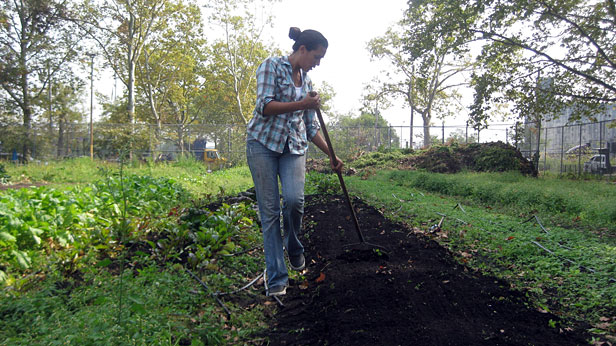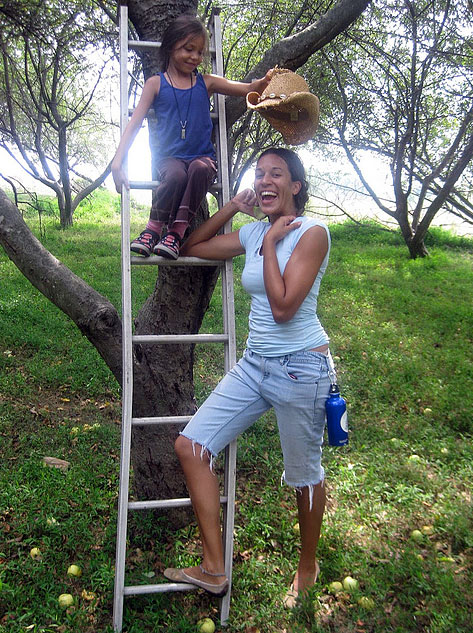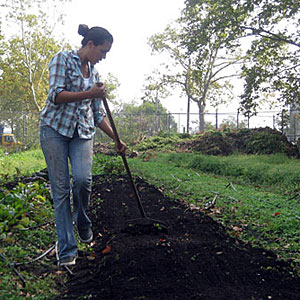 Raking it all in: Getting my hands dirty.
Raking it all in: Getting my hands dirty.
 Don’t hat me for having fun! At the Claymont Community farm in West Virginia.
Don’t hat me for having fun! At the Claymont Community farm in West Virginia.
I’m stuck on this concept of blending contrasts. It may have to do with being the only brown girl I know interested in farming (although this really shouldn’t be a contrast at all); or maybe it has to do with going from D.C. political advocate to farmer-girl overnight.
Either way, blending things that aren’t expected to go together is my thing, always has been. After all, I’m a girl born of blended love: young hazel-eyed Catholic girl from Texas meets aspiring Black Panther from the dirty South. Their eyes lock in a club in L.A.The rest is history — out pops me.
I was always blending contrasts throughout my childhood without knowing it. I was just being myself. I was the tomboy who dreamed of romance; the shy girl who loved the theatre spotlight; the only girl of color for miles who not only listened to country music, but danced to it. And nothing’s changed. Now I’m the advertising grad who despises consumerism; the advocate who hates public speaking; and the brown girl who wants to farm … in the middle of the city much less.
So, this summer I said goodbye to Washington, D.C., a job, a sweet house, great people, and a guy to transplant myself onto an organic farm and dig barefoot in the mud.
Why? Well, the mud splattering was not the main objective, although it was a fun perk. Nor was the prospect of settling down on an idyllic farm in the countryside.
It was about finally diving headfirst into my passion, and confronting myself and the rest of the food movement with the issue of race and class while doing so.
I am into food. Not like a foodie into food, but like a farmer into food. I spend my weekends working at farmers markets, volunteering with local neighborhood farms and youth gardens, and trying to make things grow in the backyard garden I planted with my housemates. All I seem to read about is soil microbes, plant identification, and statistics on our pesticide-ridden food industry. I plan my food shopping around where and when I can get the most local food, and I’ve become obsessed with experimenting in the kitchen to have the least amount of processed food possible. All the while I constantly think about how much harder that all would be if I lived in southeast D.C. as opposed to northwest, and maybe earned below the poverty line and had kids to raise.
Over the past three years I’ve been organizing and advocating on progressive campaigns for environmental issues, health care, and social justice. I realized that my activism on these issues and my passion for food and ag intersected perfectly and even had a name: food justice. I guess I’m now a “food activist.”
I want to learn how to grow it more efficiently and more harmoniously with our planet. I want to make sure it’s healthy for my body and my environment. I want to make sure it gets to those in need of it. Some of my friends don’t understand why and how farming is calling to me, but it is — loud and clear.
So I’ve packed up all my things and set off on the first step of this food journey: Learn how to grow it.
I’m really not too different from many other young people picking up the pitchfork and joining the ranks of the rapidly growing food movement … except that I seem to be the only person of color I know doing so. In fact, in my exploration from afar of the farming movement, I found very few farms and food-justice organizations being run by blacks or Latinos. Race has long been a hot topic in the environmental movement, but it saddened me to realize that, for the most part, this exciting food movement that I so badly want to be a part of is not even being led by the communities that most need it to take root.
It could even be said that farming and the black community embody some sort of contrast. If you think about the history of agriculture in our country, you can see how it has come to this. America’s agriculture industry was made on the backs of black slaves, starting with the cotton fields in the South and continuing through the long history of black families as sharecroppers after emancipation. Thus agriculture can still be viewed as disempowering if you’re black.
I feel that can no longer be so. I have to go out and dig deeper for minority-led farms firsthand. And if I come up shorthanded, I hope to help blend that contrast up and turn it around, because we need to be viewing this agriculture movement as an empowering act for our minority communities, especially our youth.
So I am riding off into the sunset, with my dusty backpack, my journal, and bug spray in hand, to apprentice, volunteer, and WWOOF my way around organic and urban farms across the country. I’m particularly seeking out those led by black and Latino farmers. My trip has begun on a rural farm in West Virginia, far from the hungry streets of some D.C. communities, but it will ultimately focus on farm and food-justice organizations in cities like Brooklyn, Detroit, Oakland, and Chicago — and any cities you may suggest!
I’m on a mission to continue blending contrasts in the hopes of making something beautiful. Add farm. Add yours truly. Press blend.


